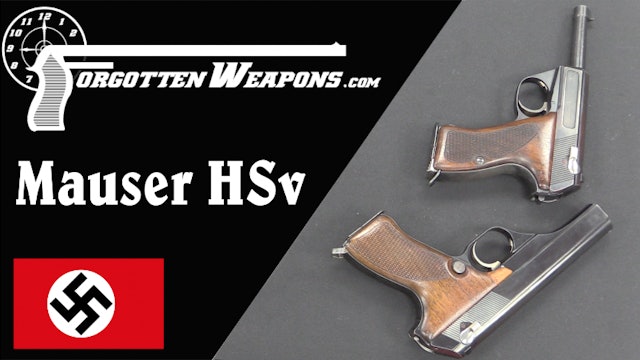-
Colt 1907 Trials Pistol
The Colt 1907 was one of the significant developmental iterations of the design that would eventually be adopted as the Model 1911 by the US military. This pistol began as John Browning’s Model 1900 in .38 caliber, with the .45ACP cartridge being first created for the Model 1905 iteration. That 1...
-
Mauser Selbstlader M1916 (Infantry Version)
The Mauser Selbstlader M1915 was the result of many years of work by the Mauser brothers to develop a semiautomatic rifle suitable for military use. They tried many different types of operating systems, and this one is a particularly unusual recoil-operated mechanism.
Only about 600 of these rif...
-
Colt Model 1929 Prototype .276 Rifle, by Ed Browning
On October 1, 1928, the US War Department published a request for semiautomatic rifle designs. The Colt company submitted this .276 caliber rifle to the ensuing trials in 1929. It was designed by Jonathan Edward "Ed" Browning (half brother of John Moses Browning) and was a recoil-operated, tiltin...
-
Prototype CZ-38 Trials Rifle
Like most other nations with modern military forces. Czechoslovakia was interested in developing a semiautomatic infantry rifle in the 1920s and 1930s. The most successful such rifle to come out of Czech factory during this time was The ZH-29, but it did have competition. A major series of trials...
-
W.A.R. - the Winchester Automatic Rifle
With the failure of the G30M and G30R to lead to any military orders (American or otherwise), the Winchester company took the advice of the Ordnance Department to scale the design up to an automatic rifle. The BAR had a number of known shortcomings in WWII, and the military was interested in repl...
-
Spanish Astra 900 Stocked Pistol
The Astra 900 was a pistol developed to take advantage of a large Chinese demand for semiauto pistols with shoulder stocks, following on the massive sales of the Mauser C96 "Broomhandle" in that country. In the 1920s and 30s, civil war in China drove a huge market in arms, but international treat...
-
Sturmgewehr MP-44 Part I: Mechanics
The MP-43 (which is mechanically identical to the MP-44 and StG-44; the differences are the subject for another video later) is a tilting bolt rifle with a long stroke gas piston. It was manufactured primarily from complex sheet steel stampings, as a way to minimize the amount of high-quality and...
-
Beretta Model 1931 & 1937 Experimental Semiauto Rifles
In the 1930s, the Italian military (like all major military forces at the time) was investigating options for a semiautomatic service rifle. Beretta's Tulio Marengoni developed one such rifle, and submitted it in two forms.
The first version of the rifle was produced in 1931, chambered for the t...
-
US WW2 Springfield Sniping Rifles (M1903A4, M1903A1)
The primary sniper rifle used by the United States in World War II was the M1903A4 Springfield, a version of the exisiting 1903A3 with the iron sights removed and replaced with a Weaver 330C scope (adopted by the military as the M73B1). This was a low-power optic, but was centrally mounted on the...
-
Winchester G30M
With the death of Jonathan "Ed" Browning in 1939, development of the Winchester G30 rifle was passed into the hands of a new employee at Winchester by the name of David Marshall Williams. Williams would become widely known as "Carbine" Williams in later years thanks to Jimmy Stewart and Hollywood...
-
Light Fifty: the Barrett M82A1
The story of the development of the Barrett M82 .50 BMG semiauto rifle is really a neat story - much more interesting than most people probably expect, and reminiscent of many firearms development stories of the 1800s. Ronnie Barrett was working as a photographer in the late 70s, and became inter...
-
Experimental Primer-Actuated Semiauto Springfield 1903
During the 1920s, a lot of experimental rifle development work was being done in the US. The military was interested in finding a semiautomatic rifle, and plenty of inventors were eager to get that valuable military contract. One particular item of interest to the military was the possibility of ...
-
Prototype Mauser HSv Pistols
When the German military finally could no longer tolerate the expense of the P.08 Luger in the late 1930s, they held a trial of possible replacements. The three main entrants were BSW with a gas-operated pistol, Walther with what would ultimately be accepted as the P.38, and Mauser with it's expe...
-
Ed Browning's Winchester G30 Prototypes
After Jonathan Edward "Ed" Browning had his 1929 rifle dropped form US military testing, he took the design back to his shop in Utah and kept working on it. By 1938 he had made enough improvements that he was ready to present the gun to Winchester, hoping they would be interested in purchasing th...
-
Japanese ZH-29 Copy by Tokyo Gas & Electric
The Japanese military experimented with self-loading rifle designs through the 1930s, and had 4 major rifles in testing during that period. One was a new design by Kijiro Nambu, one was a Pedersen copy made by the Tokyo Army Arsenal, one was a gas operated toggle locking rifle by the Nippon Speci...
-
US WWI Sniping Rifles (USMC & Army) M1903 A5
The United States had two primary types of sniper rifles during World War One, although both were based on the M1903 Springfield rifle.
The most common optic used was the Warner & Swasey "Telescopic Musket Sight", a rather clumsy prismatic optic mounted on the left side of the rifle, on a detach...
-
Semiauto RPD Light Machine Gun
The RPD was the first belt-fed light machine gun (or squad automatic weapon) developed by the Soviet Union. It was designed in 1944 for the then-new M43 cartridge (7.62x39mm), although wartime exigencies followed by post-war rebuilding prevented it from being issued until the 1950s. It is a fairl...
-
US WW2 M1903 Springfield Sniping Rifles
The primary sniper rifle used by the United States in World War II was the M1903A4 Springfield, a version of the exisiting 1903A3 with the iron sights removed and replaced with a Weaver 330C scope (adopted by the military as the M73B1). This was a low-power optic, but was centrally mounted on the...
-
Colt Prototype "Zig-Zag" Root 1855 Revolvers
The 1855 “Root” pocket revolver was a reasonably successful design for the Colt company, although it was not the best mechanical design. The side hammer design used the cylinder axis to rotate and lock in place instead of using the rear face of the cylinder, which resulted in several small and de...
-
Ethiopian ZH-29 and Czech Experimental Z-37
The ZH-29 was an influential early semiautomatic military rifle, although not one that saw any significant adoption. As best I can tell, only two countries purchased them in any quantity: China and Ethiopia. This ZH-29 is an Ethiopian contract example, with an Ethiopian Lion of Judah on the recei...
-
Königliche Marine (Prussian Navy) Colt 1851 Rig
In 1855, Prussian customs officials in Antwerp discovered a shipment of 3,000 Colt 1851 Navy model revolvers (and their accouterments) hidden in bales of cotton being shipped from New York to Russia. Prussia was a neutral power in the ongoing Crimean War, but had prohibited transit of arms across...
-
Browning M2HB .50 BMG at the Range
The Browning M2 heavy machine gun is one of the longest serving firearms in US military service, and still going strong. Let's take this one out to the range and find out why!
-
British L66A1: A Pistol for Northern Ireland
In 1974, the British Royal Army Ordnance Corps purchased about 3,000 .22lr caliber Walther PP pistols to issue as Personal Defense Weapons to service members of the Ulster Defense Regiment. These were to be issued to servicemen (and women) who faced personal threats to their lives. the choice of ...
-
Colombian 7.62mm NATO M1 Garand Conversion
After World War Two, Colombia adopted the .30-06 cartridge as standard, purchasing a thousand .30-06 FN49 rifles and 19,000 surplus American M1 Garand rifles. With the subsequent development of the 7.62mm NATO cartridge, Colombia experimented briefly with converting their existing Garand rifles t...

























